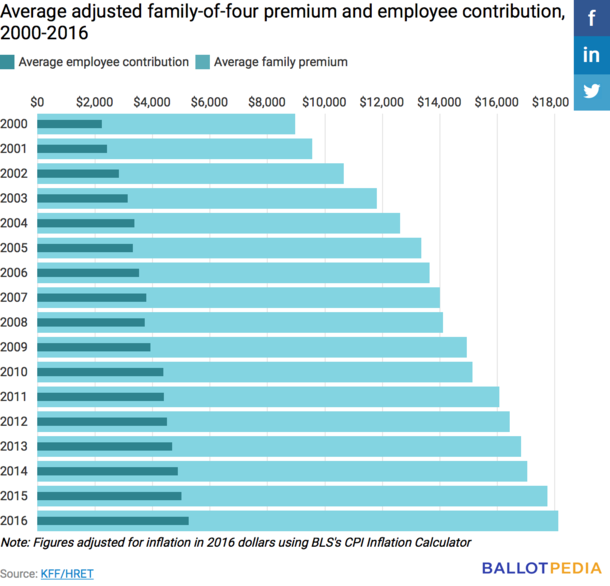This Giving Tuesday, help ensure voters have the information they need to make confident, informed decisions. Donate now!
Fact check/Did healthcare premiums for families double under George W. Bush?
Fact check: Did healthcare premiums for families double under George W. Bush?

Bernie Sanders campaigning for president in 2016.
At a town hall debate on healthcare, Sen. Ted Cruz said that Congress should repeal the Affordable Care Act (ACA) because, in part, voters are “tired of premiums going up.” Sen. Bernie Sanders responded, “Before the Affordable Care Act, as Ted probably knows, if you were a family of four during the eight years under George Bush, your premiums doubled.”[1]
Is Sanders correct that the health insurance premium for a family of four doubled during the administration of George W. Bush?[2]
Sanders is incorrect. Health insurance premiums did not double during Bush’s terms.
Sanders’ staff identified the Kaiser Family Foundation’s Employer Benefits Annual Survey as the source for his claim. The survey covers the costs of employer-sponsored group coverage, which comprises nearly 56 percent of nonelderly health insurance in the United States.[3][4][5][6]
According to the Kaiser survey, the average annual employee contribution for a family of four increased 88 percent between 2001 and 2008. However, when adjusted for inflation (in 2016 dollars), the average contribution increased by 54 percent.[3][7] A second survey by the federal government’s Agency for Healthcare Research and Quality found that the average annual employee contribution for a family of four increased by 27 percent between 2003 and 2008 when adjusted for inflation (in 2016 dollars).[8][9]
The Congressional Budget Office (CBO) reported that consistent, representative long-term data for nongroup insurance premiums is difficult to come by. According to CBO, premiums for nongroup insurance since 2008 have been lower, on average, than employer-sponsored plans. However, the CBO data for nongroup rates are inconsistent.[10][11]
Premiums under Bush
According to a member of Sen. Sanders’ staff, his claim was based on data from the Employer Benefits Annual Survey (EBAS), conducted by the Kaiser Family Foundation (KFF) and the Health Research & Educational Trust (HRET).[2] Their survey has been conducted since 1999, with about 2,000 private and non-federal public employers participating each year. The survey asks for both employer and employee contributions for single and family plan premiums, among other things.[12][13]
Based on the results of this survey, the total annual premium for a family-of-four plan increased from $7,061 in 2001, the first year of Bush’s presidency, to $12,680 in 2008, Bush’s final year in office. Adjusted into constant 2016 dollars, this is a 48 percent increase.
The average annual premium paid by an employee (for a family of four) was $1,787 in 2001, and $3,354 in 2008. In constant 2016 dollars, the difference is a 54 percent increase.[3]
A similar survey has been conducted since 1996 by the Agency for Healthcare Research and Quality, which is within the Department of Health and Human Services. The Medical Expenditure Panel Survey (MEPS) asks approximately 39,000 private-sector employers each year about their insurance costs.[14][15]
According to the survey results, the premium for a family of four increased by 35 percent between 2001 and 2008 (from $10,176 to $13,709 in constant 2016 dollars). Between 2003 and 2008, employee contributions increased by 27 percent (from $2,978 to $3,783 in constant 2016 dollars).[8]
Consistent, representative long-term data for nongroup insurance rates is difficult to come by, according to the Congressional Budget Office. Since 2008, according to CBO, premiums for nongroup insurance have been lower, on average, than employer-sponsored insurance premiums, in part because nongroup coverage tends to be less extensive and because, in part, insurers could deny coverage to people with costly pre-existing conditions before the Affordable Care Act.[10]
Out-of-pocket costs
Health care costs include not only premiums but spending on coinsurance, copayments, and deductibles.
For example, the federal government survey found that the deductible for an average family-of-four plan increased 31 percent between 2003 and 2008 (adjusted to 2016 dollars).[16]
The Milliman Medical Index (MMI) measures total out-of-pocket costs for clients of preferred-provider organizations (PPO), which are networks of service providers that have negotiated rates with insurers. According to the Kaiser Family Foundation survey, PPOs are the most common type of employer-sponsored plan, with 48 percent of covered workers enrolled in them.[17][18]
The index reflects out-of-pocket costs including copayments, deductibles, and coinsurance. Between 2001 and 2008, the out-of-pocket costs for a family of four increased by an annual average of 9 percent.[18][19]
Conclusion
At a town hall debate on health care, Sen. Bernie Sanders claimed, "Before the Affordable Care Act … if you were a family of four during the eight years under George Bush, your premiums doubled."[1]
Sanders’ claim is incorrect. Average premiums for a family of four did not double during Bush’s presidency.
Sanders’ staff identified the Kaiser Family Foundation’s Employer Benefits Annual Survey as the source for his claim. According to the Kaiser survey, the average annual employee contribution to cover a family of four increased 88 percent between 2001 and 2008. However, when adjusted for inflation (in 2016 dollars), the average contribution increased by 54 percent.[3]
A second employer survey by the federal government’s Agency for Healthcare Research and Quality (with data available beginning in 2003) found that the average annual employee contribution for a family of four increased by 27 percent between 2003 and 2008, adjusted for inflation.[8]
See also
- Fact check/Could 36,000 people die if the ACA is partially repealed?
- Fact check/Have most ACA exchange customers chosen bronze or silver plans?
- Fact check/Do ACA premium hikes affect a "relatively small number of Americans"?
Sources and Notes
- ↑ 1.0 1.1 CNN, “Sens. Bernie Sanders and Ted Cruz Debate over U.S. Health Care System,” February 7, 2017
- ↑ 2.0 2.1 Josh Miller-Lewis, deputy communications director for Sen. Sanders, confirmed with Ballotpedia that his source was the Kaiser Family Foundation’s Employer Benefits Annual Survey. Amee LaTour, “Email communication with Josh Miller-Lewis,” March 12, 2017
- ↑ 3.0 3.1 3.2 3.3 The Kaiser Family Foundation and Health Research & Educational Trust, “Employer Health Benefits 2016 Annual Survey,” September 2016 (Page 90)
- ↑ According to Kaiser, nongroup insurance covers 7.9 of the nonelderly, Medicaid covers 21.8 percent, and 4 percent have other forms of public insurance such as military insurance, while 10.5 percent were uninsured.
- ↑ The Henry J. Kaiser Family Foundation, “The Uninsured: A Primer,” November 2016
- ↑ The Census Bureau reported similar figures for 2015 from their Current Population Survey. Of the total population, they report that, throughout the year, 55.7 percent had employer-sponsored insurance, 19.6 percent had Medicaid, 16.3 percent had Medicare, 16.3 percent had nongroup insurance, and 4.7 percent had military coverage. More than half of respondents who reported having nongroup (direct purchase) insurance, military insurance, or Medicare reported having had more than one coverage source throughout the year; therefore, the percentages do not add up to 100. United States Census Bureau, “Health Insurance Coverage in the United States: 2015,” September 2016
- ↑ All adjustments for inflation are based on the Consumer Price Index Inflation Calculator provided by the Bureau of Labor Statistics. Bureau of Labor Statistics, “CPI Inflation Calculator,” accessed March 17, 2017
- ↑ 8.0 8.1 8.2 Agency for Healthcare Research and Quality, “MEPS Insurance Component Chartbook 2015,” August 2016 (Page 109)
- ↑ Between 2001 and 2003, the Kaiser survey found an increase in employee contribution of 30 percent and an increase of 19 percent between 2003 and 2008.
- ↑ 10.0 10.1 Congressional Budget Office, “Private Health Insurance Premiums and Federal Policy,” February 2016
- ↑ Ballotpedia also reached out to Kaiser Family Foundation (KFF) and the National Association of Insurance Commissioners (NAIC) but they did not have data on nongroup premiums. Amee LaTour, “Email communications with NAIC’s senior communications specialist Katherine Jones and KFF’s marketplace contact," April 5 and April 6, 2017
- ↑ Family coverage refers to coverage for families of four.
- ↑ The Henry J. Kaiser Family Foundation, “Premiums and Worker Contributions Among Workers Covered by Employer-Sponsored Coverage, 1999-2016,” September 14, 2016
- ↑ Response rates have ranged from 66 to 83 percent. Agency for Healthcare Research and Quality, “MEPS-IC Response Rates,” accessed March 17, 2017 Data for years 1996-2002.
- ↑ Data on annual employee contributions is available for 2003 and beyond. The most recent year for which premiums have been reported by the MEPS is 2015. Agency for Healthcare Research and Quality, “MEPS Insurance Component Chartbook 2015,” August 2016 (Page 109), data for years 2003-2015.
- ↑ Agency for Healthcare Research and Quality, “MEPS Insurance Component Chartbook 2015,” August 2016 (Page 149)
- ↑ The Kaiser Family Foundation and Health Research & Educational Trust, “Employer Health Benefits 2016 Annual Survey,” September 2016 (Page 3)
- ↑ 18.0 18.1 Milliman uses its own research data in addition to other industry data sources concerning average in-network provider fees, utilization levels, and plan benefit levels when calculating out-of-pocket costs. Milliman, “2016 Milliman Medical Index,” May 2016
- ↑ Milliman, “Milliman Medical Index Archives,” accessed March 19, 2017 Years 2011, 2009, and 2005.
Launched in October 2015 and active through October 2018, Fact Check by Ballotpedia examined claims made by elected officials, political appointees, and political candidates at the federal, state, and local levels. We evaluated claims made by politicians of all backgrounds and affiliations, subjecting them to the same objective and neutral examination process. As of 2025, Ballotpedia staff periodically review these articles to revaluate and reaffirm our conclusions. Please email us with questions, comments, or concerns about these articles. To learn more about fact-checking, click here.
Contact
More Fact Checks
|
|
|
|







